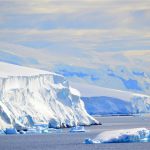Only 40,000 people visit Antarctica annually, according to statistics from the International Association of Antarctic Tour Operators (IAATO). And only a little more than half of those visitors actually set foot on the continent.
While Antarctica awes even travelers who do not stand atop its frozen ground (vessels carrying more than 500 passengers are not allowed to execute landings to bring their guests ashore), to actually plant two feet on Antarctica is quite something else.
Nothing will do this place justice like a good photo…but we’ll give you some reasons anyways.
1. Seven Continents, check that off the bucket list!
2.Up-close encounters with penguins and other wildlife not found elsewhere
3. Experiencing History
4. Lifelong connections with fellow passengers (there’s usually only arond 100 of you onboard!)
5. A new kind of nature
A few factual superlatives:
- Antarctica is the world’s coldest, driest and windiest place.
- It is the earth’s largest dessert, its largest wilderness area.
- It is a land of extremes.
- Earth’s coldest temperatures were recorded here in August 2010: -94.7C (-135.8F).
Figures like those may have you asking whether Antarctica is too cold for a cruise. Nope.
Temperatures on the Antarctic Peninsula, which is where you spent most of our time, averaged around the freezing mark during the Austral summer. You’ll even have days so warm that you remove that cozy parka.
In fact, you’re traveling at about the same latitude (but on the bottom side of the world) as Stockholm, Sweden and never cross the Antarctic Circle, which is quite a distance farther south — and presumably blocked by ice.
Going Ashore
When you do go ashore, you’re given a short briefing by one of the Expedition Team members before being turned loose. These short briefings are important and informative, and let you know where you can and cannot go, and at what time you must be back at the Polarcirkel boats for the return to the ship. 
Sometimes you can hike along the beach for kilometres so long as they were mindful of the carefully-placed orange cones and flags that denoted where the Adelie Penguin rookeries started. Guests are asked not to step over to the other side of the cones, though this can be difficult in some instances to determine which is the “right” side of the cone to be on.
While walking along the beach, frequent stops are made to touch the many icebergs that wash ashore. Contrary to what you might think, these aren’t made up of smooth, shiny ice like you’d find in the ice cube tray in your freezer; rather, most were made up largely of ice and snow pellets that you could scoop up in your hand.
And our unexpected recommendation for anyone travelling to Antarctica: find yourself a rock or a snowbank and sit down. Don’t move. Just watch and listen.
You can hear the sounds of the ice crackling as it melted in the warmth of Antarctica’s summer sun. Waves gently rolled ashore like the soundtrack to some high-end spa. Adelie Penguins called out to each other in the distance.
Aside from the odd Polarcirkel boat zipping back and forth from shore, not a single man-made sound will be heard. No car horns, traffic, airplanes, advertising, or other white noise. Just silence.
Ready to cross this off your bucket list?
See our featured Antarctica sailings >>



